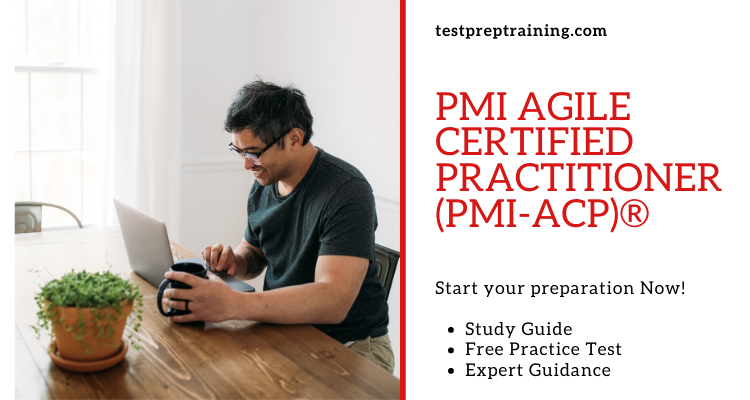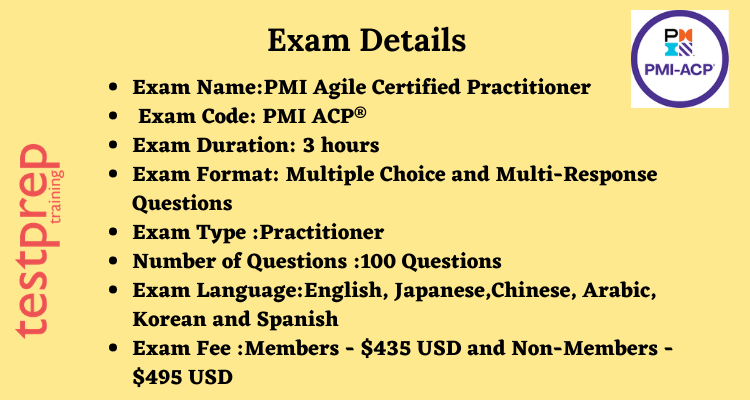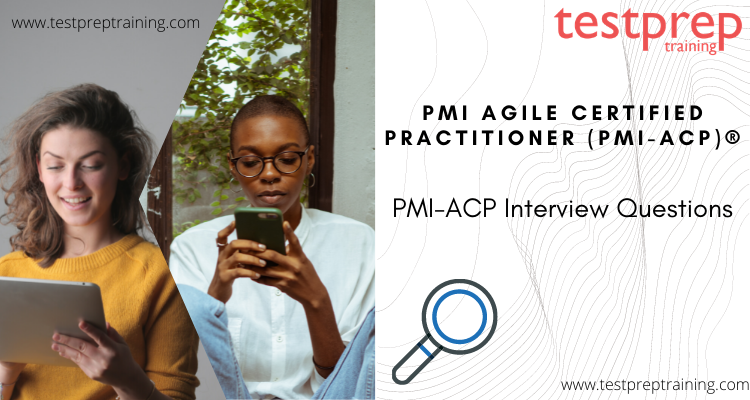PMI Agile Certified Practitioner (PMI-ACP)®

PMI Agile Certified Practitioner (PMI-ACP)® examination is one of the prime institutes for aims to identify a candidate’s knowledge of agile principles and their skill with agile techniques. After completing this certification you will be able to demonstrate your agile knowledge. The PMI-ACP spans many approaches to agile such as Scrum, Kanban, Lean, extreme programming (XP), and test-driven development (TDD.) So, it will increase your versatility, wherever your projects may take you.
Who should apply for this certification ?
If you are a professional working on agile teams or if your organization is adopting agile practices, the PMI-ACP is a good choice for you. You should definitely complete this certification for career advancement.
Exam Prerequisites
There are a few things that a candidate should know and have experience in the relevant field. So, that they can have a better and deep understanding of this certification. The below mentioned are the required skills and knowledge:
- Secondary degree
- 21 contact hours of training in agile practices
- 12 months of general project experience within the last 5 years. A current PMP® or PgMP® will satisfy this requirement but is not required to apply for the PMI-ACP and
- 8 months of agile project experience within the last 3 years
Exam Details
The PMI Agile Certified Practitioner (PMI-ACP)® Certification Exam consists of 120 multiple-choice questions. The total time given to complete the examination is three hours. Also, to maintain your PMI-ACP, you must earn 30 professional development units (PDUs) in agile topics every three years. The best part of this examination is that you can appear for it in English, Arabic, Japanese, Korean, Portuguese and Spanish languages. Moreover, the PMI Agile Certified Practitioner (PMI-ACP) Cost is INR 25,196 for members and INR 38,229 for non-members

Exam Registration
To register yourself for the PMI Agile Certified Practitioner examination do the following:
- Go to the official PMI ACP exam guide page.
- You need to register for an online proctored examination. Also, you can directly go to the login page.
- Follow the instructions and complete the registration accordingly.
- Once you have started your application, you are given 10 days time to complete the registration and make the payment.
Check: PMI Agile Certified Practitioner (PMI-ACP)® Interview questions
For more information, click on PMI-ACP FAQ

Course Outline of PMI Agile Certified Practitioner Exam
PMI Agile Certified Practitioner (PMI-ACP)® Examination Content Outline coves the following domains:
Domain I Agile Principles and Mindset
- Advocate for agile principles by modeling those principles and discussing agile values in order to develop a shared mindset across the team as well as between the customer and the team.
- Help ensure that everyone has a common understanding of the values and principles of agile and common knowledge around the agile practices and terminology being used in order to work effectively.
- Support change at the system or organization level by educating the organization and influencing processes, behaviors, and people in order to make the organization more effective and efficient.
- Practice visualization by maintaining highly visible information radiators showing real progress and real team performance in order: to enhance transparency and trust.
- Contribute to a safe and trustful team environment by allowing everyone to experiment and make mistakes so that each can learn and continuously improve the way he or she works.
- Enhance creativity by experimenting with new techniques and process ideas in order to discover more efficient and effective ways of working.
- Encourage team members to share knowledge by collaborating and working together in order to lower risks around knowledge silos and reduce bottlenecks.
- Encourage emergent leadership within the team by establishing a safe and respectful environment in which new approaches can be tried in order to make improvements and foster self-organization and empowerment.
- Practice servant leadership by supporting and encouraging others in their endeavors so that they can perform at their highest level and continue to improve.
Domain II Value-Driven Delivery
Define Positive Value
- Define deliverables by identifying units that can be produced incrementally in order to maximize their value to stakeholders while minimizing non-value-added work.
- Refine requirements by gaining consensus on the acceptance criteria for features on a just-in-time basis in order to deliver value.
- Select and tailor the team’s process based on project and organizational characteristics as well as team experience in order to optimize value delivery.
Avoid Potential Downsides
- Plan for small releasable increments by organizing requirements into minimally marketable features/minimally viable products in order to allow for the early recognition and delivery of value.
- Limit increment size and increase review frequency with appropriate stakeholders in order to identify and respond to risks early on and at a minimal cost.
- Solicit customer and user feedback by reviewing increments often in order to confirm and enhance business value.
Prioritization
- Prioritize the units of work through collaboration with stakeholders in order to optimize the value of the deliverables.
- Perform frequent review and maintenance of the work results by prioritizing and maintaining internal quality in order to reduce the overall cost of incremental development.
- Continuously identify and prioritize the environmental, operational, and infrastructure factors in order to improve the quality and value of the deliverables.
Incremental Development
- Conduct operational reviews and/or periodic checkpoints with stakeholders in order to obtain feedback and corrections to the work in progress and planned work.
- Balance development of deliverable units and risk reduction efforts by incorporating both value-producing and risk-reducing work into the backlog in order to maximize the total value proposition over time.
Domain III Stakeholder Engagement
Understand Stakeholder Needs
- Identify and engage effectively and empowered business stakeholder(s) through periodic reviews in order to ensure that the knowledge about stakeholders’ interests, needs, and expectations.
- Find and engage all stakeholders (current and future) by promoting knowledge sharing early and throughout the project to ensure the unimpeded flow of information and value throughout the span of the project.
Ensure Stakeholder Involvement
- Establish stakeholder relationships by forming a working agreement among key stakeholders in order to promote participation and effective collaboration.
- Maintain proper stakeholder involvement by continually assessing changes in the project and organization in order to ensure that new stakeholders are appropriately engaged.
- Establish collaborative behaviors among the members of the organization by fostering group decision making and conflict resolution in order to improve decision quality and reduce the time required to make decisions.
Manage Stakeholder Expectations
- Lay down a shared vision of the various project increments (products, deliverables, releases, iterations) by developing a high-level vision and supporting objectives in order to align stakeholders’ expectations and build trust.
- Establish and maintain a shared understanding of success criteria, deliverables, and acceptable trade-offs by facilitating awareness among stakeholders in order to align expectations and build trust.
- Give transparency regarding work status by communicating team progress, work quality, impediments, and risks in order to help the primary stakeholders make informed decisions.
- Provide forecasts at a level of detail that balances the need for certainty. Also, the benefits of adaptability in order to allow
stakeholders to plan effectively
Domain IV Team Performance
Team Formation
- Cooperate with the other team members to devise ground rules and internal processes in order to foster team coherence and strengthen team members’ commitment to shared outcomes.
- Help create a team that has the interpersonal and technical skills needed to achieve all known project objectives in order to create business value with minimal delay.
- Encourage team members to become generalizing specialists in order to reduce team size and bottlenecks and to create a high performing cross-functional team.
- Contribute to self-organizing the work by empowering others and encouraging emerging leaders in order to produce effective solutions and manage complexity.
- Continuously discover team and personal motivators and demotivators in order to ensure that team morale is high and team members are motivated and productive throughout the project.
Team Collaboration and Commitment
- Facilitate close communication within the team and with appropriate external stakeholders through co-location or the use of collaboration tools in order to reduce miscommunication and rework.
- Reduce distractions in order to establish a predictable outcome and optimize the value delivered.
- Participate in aligning project and team goals by sharing project vision in order to ensure the team understands how their objectives fit into the overall goals of the project.
- Encourage the team to measure its velocity by tracking and measuring actual performance in previous iterations or releases in order for members to gain a better understanding of their capacity
and create more accurate forecasts
Domain V Adaptive Planning
Levels of Planning
- Plan at multiple levels (strategic, release, iteration, daily) creating appropriate detail by using rolling wave planning and progressive elaboration to balance predictability of outcomes with the ability to exploit opportunities.
- Make planning activities visible and transparent by encouraging the participation of key stakeholders and publishing planning results in order to increase commitment level and reduce uncertainty.
- As the project unfolds, set and manage stakeholder expectations by making increasingly specific levels of commitments in order to ensure a common understanding of the expected deliverables.
Adaptation
- Adapt the cadence and the planning process based on results of periodic retrospectives about characteristics and/or the
size/complexity/criticality of the project deliverables in order to maximize value. - Inspect and adapt the project plan to reflect changes in requirements, schedule, budget, and shifting priorities based on team learning, delivery experience, stakeholder feedback, and defects in order to maximize the business value delivered.
Agile Sizing and Estimation
- Size items by using progressive elaboration techniques in order to determine likely project size independent of team velocity and external variables.
- Adjust capacity by incorporating maintenance and operations demands and other factors in order to create or update the range estimate.
- Create initial scope, schedule, and cost range estimates that reflect the current high-level understanding of the effort necessary to deliver the project in order to develop a starting point for managing the project.
- Refine scope, schedule, and cost range estimates that reflect the latest understanding of the effort necessary to deliver the project in order to manage the project.
- Continuously use data from changes in resource capacity, project size, and velocity metrics in order to evaluate the estimate to complete.
Domain VI Problem Detection and Resolution
- Create an open and safe environment by encouraging conversation and experimentation, in order to surface problems and impediments that are slowing the team down or preventing its ability to deliver value.
- Identify threats and issues by educating and engaging the team at various points in the project in order to resolve them at the appropriate time and improve processes that caused issues.
- Ensure issues are resolved by appropriate team members and/or reset expectations in light of issues that cannot be resolved in order to maximize the value delivered.
- Maintain a visible, monitored, and prioritized list of threats and issues in order to elevate accountability, encourage action, and track ownership and resolution status.
- Communicate status of threats and issues by maintaining a threat list and incorporating activities into the backlog of work in order to provide transparency
Domain VII Continuous Improvement
(Product, Process, People)
- Tailor and adapt the project process by periodically reviewing and integrating team practices, organizational culture, and delivery goals in order to ensure team effectiveness within established organizational guidelines and norms.
- Improve team processes by conducting frequent retrospectives and improvement experiments in order to continually enhance the effectiveness of the team, project, and organization.
- Seek feedback on the product by incremental delivery and frequent demonstrations in order to improve the value of the product.
- Create an environment of continuous learning by providing opportunities for people to develop their skills in order to develop a more productive team of generalizing specialists.
- Challenge existing process elements by performing a value stream analysis and removing waste in order to increase individual efficiency and team effectiveness.
- Create systemic improvements by disseminating knowledge and practices across projects and organizational boundaries in order to avoid the re-occurrence of identified problems and improve the effectiveness of the organization as a whole.
Preparatory Guide for PMI Agile Certified Practitioner (PMI-ACP)®
Here we provide you with the preparatory guide specially curated by our experts. This guide will help you throughout your journey for this exam and act as a bridge for your career advancements. We shall now elaborate preparation steps are essential in order to successfully pass the examination. So let’s dig deeper and begin our preparation.

Refer the Exam Guide
The first step is always to be aware of the exam guide and course outline. For the PMI Agile Certified Practitioner (PMI-ACP)® examination, you should visit the official website to get the course outline and exam guide for the above examination. Also, objectives play an important role, so follow this step successfully. Below are the objectives of the PMI Agile Certified Practitioner (PMI-ACP)® Course :
- Domain I. Agile Principles and Mindset 16%
- Domain II. Value-driven Delivery 20%
- Domain III. Stakeholder Engagement 17%
- Domain IV. Team Performance 16%
- Domain V. Adaptive Planning 12%
- Domain VI. Problem Detection and Resolution 10%
- Domain VII. Continuous Improvement 9%
Learning Resources
Online classes are offered by PMI, which is specially designed for helping you in clearing the examination. You can also review self-study books published by R.E.P.s and other reputable training organizations. The books which are important and can be referred to preparation are mentioned in the next section. So, it is very important to prepare from the right resources.
Reference Books
Books are the ultimate source of learning and preparation and there plenty of references available to help you prepare better together with these learning resources. Some of the suggested books which you can refer to are –


- A guide to the Project Management Body of Knowledge (PMBOK guide)
- PMI Agile Certified Practitioner: Excel With Ease, 3Rd Edition
- Also, PMI Agile Certified Practitioner (PMI-ACP)® Handbook
Also, you can get these books from the official website.
Join a Study Group
It is essential to stay connected with people who have similar aims as you. This will not help you clarify your doubts but it will also help to gain additional knowledge related to the PMI Agile Certified Practitioner (PMI-ACP)® Certification. Therefore, you should join some study groups where you can discuss the concepts with the people who have the same goal. This will help the candidate throughout their preparation.
Practice Tests
PMI Agile Certified Practitioner (PMI-ACP)® Practice Tests play a pivotal role during your exam preparation. They not only help you find out your strengths but also direct you to master your possible weak areas. also, the evolution of practice tests has done nothing but added more to its generosity. They are considered as one of the most efficient sources to study for the exam. Therefore, it is highly advised to perform more and more practice tests.


